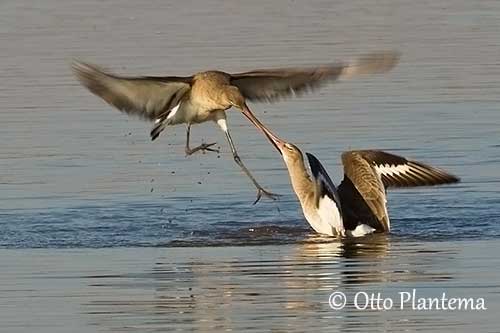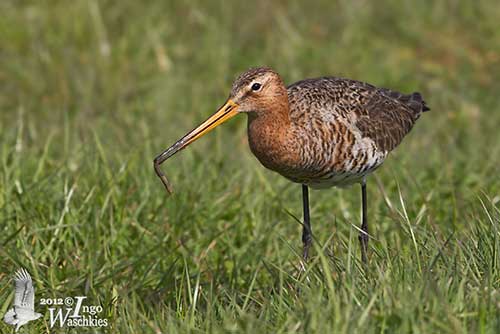
Fr: Barge à queue noire
Ang: Black-tailed Godwit
All: Uferschnepfe
Esp: Aguja Colinegra
Ita: Pittima reale
Nd: Grutto
Sd: rödspov
Photographers:
John Anderson
John Anderson Photo Galleries
Jean Michel Fenerole
Photos d’Oiseaux du monde
Steve Garvie
RAINBIRDER Photo galleries & Flickr Rainbirder
Otto Plantema
Trips around the world
Ingo Waschkies
Bird Photography
Text by Nicole Bouglouan
Sources:
HANDBOOK OF THE BIRDS OF THE WORLD Vol 3 by Josep del Hoyo-Andrew Elliott-Jordi Sargatal - Lynx Edicions - ISBN : 8487334202
THE HANDBOOK OF BIRD IDENTIFICATION FOR EUROPE AND THE WESTERN PALEARCTIC by Mark Beaman, Steve Madge - C. Helm - ISBN: 0713639601
SHOREBIRDS by Peter Hayman, John Marchant and Tony Prater – Christopher Helm – 1986 – ISBN: 0747014035
A Field Guide to the Birds of South-East Asia by Craig Robson. New Holland Publishers. ISBN: 9781780090498
THE COMPLETE BOOK OF BRITISH BIRDS – Written by “Royal Society for the Protection of Birds” experts - Préface de Magnus Magnusson - Michael Cady- Rob Hume Editors - ISBN: 0749509112
GUIDE DES LIMICOLES de D. Taylor - Delachaux et Niestlé - ISBN : 2603014080
Department of Sustainability, Environment, Water, Population and Communities
Wikipedia, the free encyclopaedia
What Bird-The ultimate Bird Guide (Mitchell Waite)
Birds of Britain - The Web Magazine for Birdwatchers
Ocean Wanderers "Ride the Wave"
Black-tailed Godwit
Limosa limosa
Charadriiformes Order – Scolopacidae Family
INTRODUCTION:
The Black-tailed Godwit is a large, long-legged Scolopacidae with a long, straight bill. It is included in the subfamily Tringinae, tribe Numeniini. It is considered the most elegant of the four godwit species.
This species breeds in both boreal and low arctic areas, and moves southwards after the breeding season. Three subspecies are recognized and share the wide range.
The Black-tailed Godwit is Near Threatened. It is vulnerable to habitat loss in the breeding range, disturbances due to changes in this habitat, predation, hunting, pollution and habitat fragmentation.

DESCRIPTION OF THE BIRD:
Biometrics:
Length: 36-44 cm – Bill nominate race: 79-123 mm
Wingspan: 70-82 cm
Weight: M: 160-440 g – F: 244-500 g
The Black-tailed Godwit male in breeding plumage has reddish-rufous head sides, neck, upper breast and upper belly, and dark barring on rest of underparts.
On the upperparts, mantle and scapulars are blotched pale chestnut, grey and black. Rest of upperparts shows variable numbers of brownish-grey feathers. The tail is black with white uppertail-coverts. On the upperwing, a white wingbar is formed by the broad white bases of primaries, and the narrower bases of secondaries.
The crown is brownish to chestnut. We can see a buffy-white supercilium from lores to ear-coverts.
The long bill is orange at base and blackish at tip. The eyes are dark brown. The long legs and the feet are dark grey to dark blue-grey.
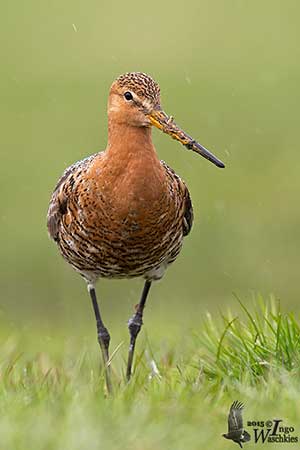
The female resembles male but she is paler and less red than male, with less barred underparts. She has slightly longer bill.
The adult in non-breeding plumage has grey-brown upperparts with white-edged wing-coverts. Foreneck and breast are grey, whereas belly and flanks are white with grey mottling on flanks. The supercilium is whitish and contrasts with the dark lores. The base of the bill is duller, mostly pale pinkish.
The juvenile resembles non-breeding adult. The crown is streaked brown and cinnamon, neck and breast are washed dull cinnamon. The upperparts are dark grey-brown with dull chestnut and buff fringes. The underparts are white with no barring.
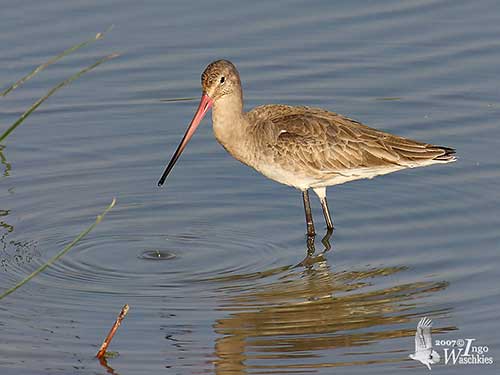
SUBSPECIES AND RANGE:
The Black-tailed Godwit has three subspecies.
L.l. islandica breeds in Iceland, Faeroes, Shetland and Lofoten Islands. It winters in Ireland, Britain, W France, Spain and Portugal.
This race is smaller than nominate with shorter bill (74-100 mm). The wings are longer and the plumage is darker.
L.l. limosa (described above) or Western Black-tailed Godwit, breeds in W and C Europe and Russia, E to upper R Yenisey. It winters in Mediterranean and sub-Saharan Africa, and E through Middle-East to W India.
L.l. melanuroides or eastern Black-tailed Godwit, has disjunct populations in Siberia, E of R Yenisey, E Mongolia, NE China and Russian Far East. It winters from India, Indochina, Taiwan and Philippines, S to Indonesia, New Guinea, Melanesia, Australia and probably New Zealand.
This race is the smallest with shorter bill (67-93 mm). It is darker red than nominate. The non-breeding adult has dark upperparts and breast.
HABITAT:
The Black-tailed Godwit breeds in lowland wet meadows or grassy marshes, damp pastures (limosa) and moorland bogs (islandica).
They winter in estuaries, lagoons with intertidal mudflats, sandy beaches, inland wetlands and ricefields.
The nominate race usually winters in freshwater habitats, while the two other races frequent estuarine habitats.
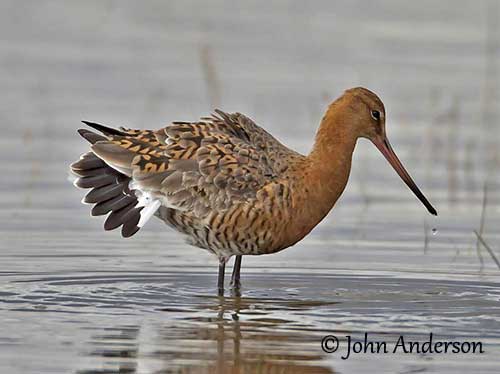
CALLS AND SONGS: SOUNDS BY XENO-CANTO
The Black-tailed Godwit is relatively silent outside breeding season. Flocks in flight give a variety of calls including a short, repeated “kip” or “kip-kip-kip”. The feeding birds utter low, deep “kett” or “chuk”.
During the flight displays, the bird climbing in the air gives nasal “wicka-wicka-wicka”, also a hoarse “wee-eeh” and a shrill, slow-paced “kititititititiw”.
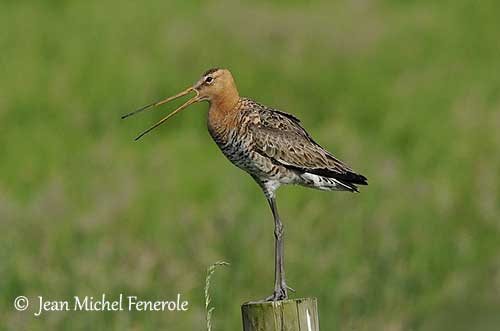
BEHAVIOUR IN THE WILD:
The Black-tailed Godwit feeds by picking and forward-probing, usually in deeper water than the Bar-tailed Godwit. The food is swallowed by upward flicks of both bill and head.
This species feeds on a variety of invertebrates such as insects and their larvae, annelids, molluscs, crustaceans, crabs, marine worms, spiders and fish eggs. It also consumes berries and seeds, mostly rice.
On the wintering grounds, the race limosa feeds primarily on plant material, mainly rice, and some larvae and snails.
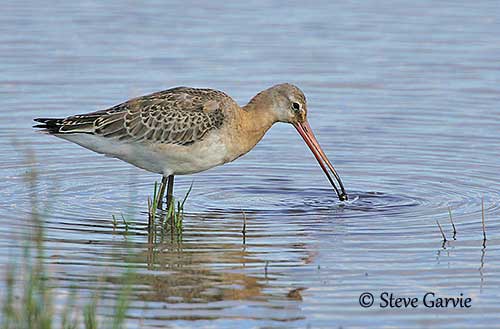
The Black-tailed Godwit is monogamous with long-term pair-bonds. The male performs elaborate courtship displays and flights while calling and strutting in front of the female. The display flight includes spectacular rolling and tumbling, and vertical dive while rolling.
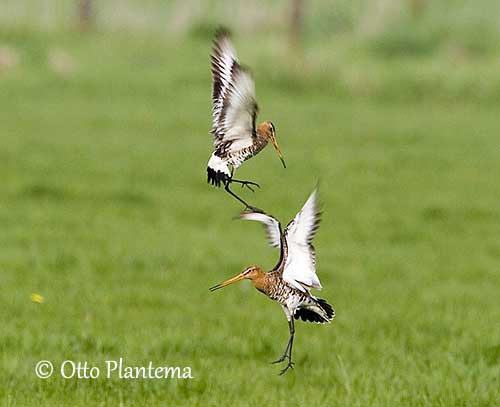

The Black-tailed Godwit often forms loosely colonial groups. They mob aggressively predators and intruders. Outside breeding season, this gregarious species forms large flocks of thousands in suitable areas. They may roosts in large concentrations during migration.

It is migratory and travels in broad front overland. It performs long-distance flights between some stopovers and its wintering grounds. The southern migration occurs from late June to October, and the return migration to north takes place between February and April.
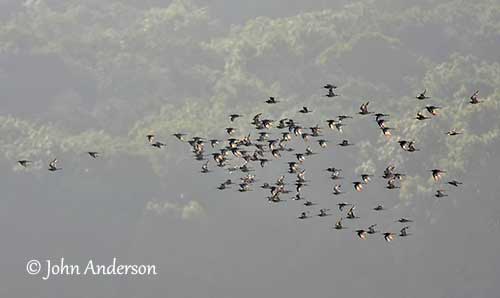
The Black-tailed Godwit has strong, direct flight with horizontal body and legs held straight back.
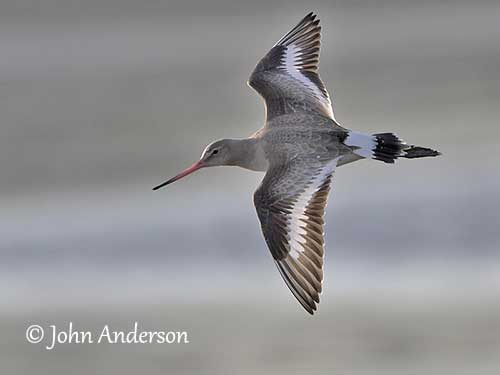
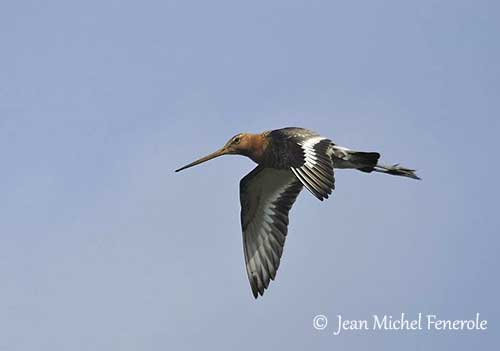
REPRODUCTION OF THIS SPECIES:
The laying takes place between April and mid-June. The Black-tailed Godwit nests on the ground among the short vegetation, usually in wet grasslands near freshwater marshes.
The female lays 3-5 olive-green eggs with brown markings. Both adults share the incubation during 22-24 days. At hatching, the chicks have pale pinkish-cinnamon down with dark bands and mottling on back. Both parents tend them. The young fledge about 28-34 days after hatching.
The Black-tailed Godwit produces a single brood per season, but a replacement clutch is laid is the first is lost.

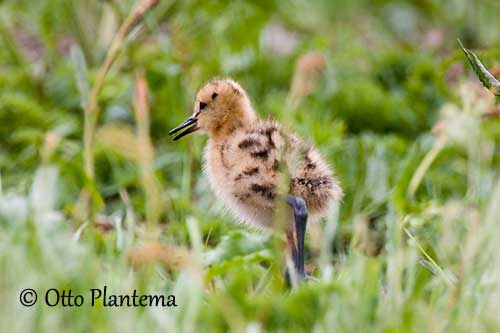
PROTECTION / THREATS / STATUS:
The Black-tailed Godwit is threatened by habitat loss due to changes in the habitat with drainage of wet areas for agriculture, disturbance, pollution, hunting, grazing and trampling of nests by cattle, reduction of prey abundance following changes in agriculture, habitat fragmentation and climate change.
The population is estimated to number 140,000/270,000 pairs. This population is suspected to be declining, but there is some degree of uncertainty about the sub-populations.
The Black-tailed Godwit is currently listed as Near Threatened.
